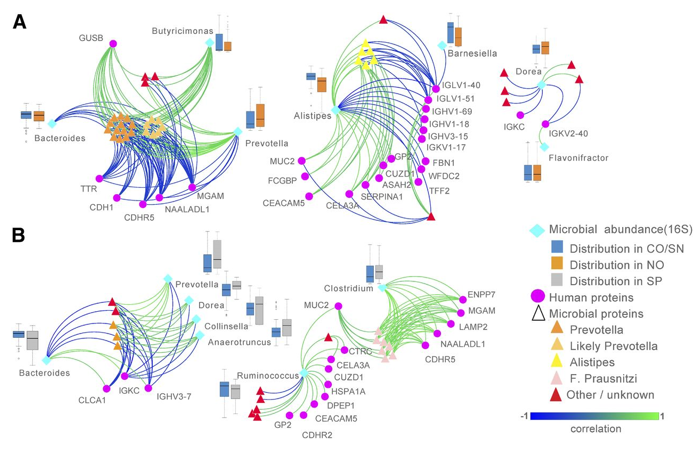The host, through proteins, metabolites, small molecules, and nucleic acids, communicates with microbiota. In order to modify host cellular functions and immune responses, the microbiota encompasses a variety of effectors. They have specialized host interactions, and network representation allows these relationships to be effectively visualized. Most bacterial and eukaryotic pathogens proteins are not available to attach to host proteins, but some of their proteins either connect to or reach the host cell to host surface receptors and engage with cytoplasmic proteins of the host. Numerous bacterial species have a syringe-like device through which they immediately infuse the bacterial effectors into the cytoplasm of the host cell. They are specifically based on key processes through host interactions altering host physiological signaling, evading the host immune framework, altering the cytoskeletal organization, altering membrane and vesicular trafficking, promoting pathogen passage into the host, shifting the cell cycle, and modulating apoptosis. All are intended within the host to guarantee their survival and replication. Host signaling mechanisms that are microbiota-targeted and turned on or off may modify the outcome of the cell. For both commensals and pathogens, uncovering the HMIs can elaborate how they reconfigure the paths of host signaling and help establish new therapeutic strategies.
Figure 1. Intestinal Metaproteomics Reveals Host-Microbiota Interactions. (Gavin, 2018)
Our Interaction Proteomics and Protein Network Analysis Services
As a preeminent company with many years of expertise in proteomics, CD Genomics offers comprehensive interaction proteomics and protein network analysis services. For targeted and untargeted metaproteomic assessment, we show the state-of-the-art 2D-LC approach.
In metaproteomic studies, two-dimensional liquid chromatography (2D-LC) is the most commonly utilized multidimensional liquid chromatographic method and is suitable for the segregation of proteins with large molecular size variation, proteins with reduced abundance, and hydrophobic proteins. 2D-LC can be employed to resolve issues with complicated naturally occurring mixtures, biomarkers, (meta)proteomics, and metabolomics for different biological situations. 2D-LC provides an enormous volume of qualitative and quantitative info when used in mixture with mass spectrometry, which greatly enhances detection depth and plays an essential role in the segregation of complicated and hard-to-separate components in the areas of proteomics and metaproteomics. These enhanced displacements, however, usually came at the cost of long analysis times (such as several hours to days) and thus 2D-LC was really a niche strategy constrained to a small fraction of all separations of the liquid phase.
Workflow and Bioinformatics Analysis
Our Advantages
- Separation power is greatly improved.
- Enabling automatic performance to avoid tedious and time-consuming transmission of line fraction between the separation frameworks.
- Enhanced classification power. When the sensor with detection capacities is coupled with Multi-Dimensional Liquid Chromatography (MDLC) system, this benefit can be further enhanced.
Bioinformatics Analysis
| Analysis Content | Details |
| PCA | To evaluate protein trajectories, primary component analysis is utilized. |
| Cluster Analysis | One of the significant data mining methodologies for exploring information in multidimensional data is cluster assessment. It is used within a set of data of interest, such as proteins, to identify patterns or groups of similar objects. |
| Identification of Biomarkers | Compared to free databases (HMDB, LIPID MAPS, KEGG, etc.), which help to elucidate metabolites/biomarkers and particular processes, biomarker identification is available. |
| Metabolic pathways linking analysis | The allocation of specific proteins to selected metabolic processes will make it easier to recognize key cellular signaling and metabolic networks and will reveal the microbiota's biological processes. |
In the field of gut microbiota research, CD Genomics is committed to providing the highest level of service. Depending on your sample and research purpose, we will offer the most preferred strategies. To know more about our interaction proteomics and protein network analysis services, you may contact us.
References
1. Cacciola F, Mangraviti D, Mondello L, Dugo P. Hyphenations of 2D capillary-based LC with mass spectrometry. InHyphenations of Capillary Chromatography with Mass Spectrometry 2020 (pp. 369-412). Elsevier.
2. Gavin PG, Mullaney JA, Loo D, et al. Intestinal metaproteomics reveals host-microbiota interactions in subjects at risk for type 1 diabetes. Diabetes Care. 2018, 41(10).
3. Guven-Maiorov E, Tsai CJ, Nussinov R. Structural host-microbiota interaction networks. PLoS computational biology. 2017 Oct 12;13(10):e1005579.
4. Lazar AG, Romanciuc F, Socaciu MA, Socaciu C. Bioinformatics Tools for Metabolomic Data Processing and Analysis Using Untargeted Liquid Chromatography Coupled With Mass Spectrometry. Bulletin of the University of Agricultural Sciences & Veterinary Medicine Cluj-Napoca. Animal Science & Biotechnologies. 2015, 72(2).
*For Research Use Only. Not for use in diagnostic procedures.



